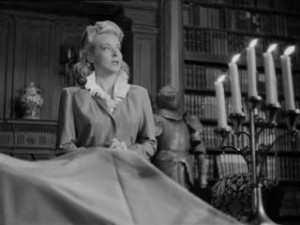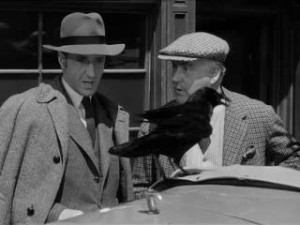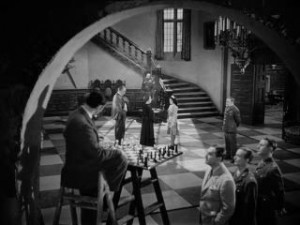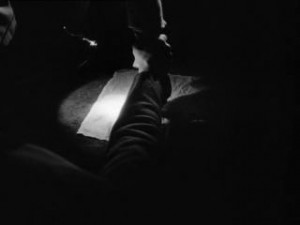That night, from the darkness staggers Watson’s assistant, Dr. Robert Sexton (Arthur Margetson), who has been stabbed, though not seriously, on his way through the garden. As Richard Todd does in Alfred Hitchcock’s Stage Fright, the account Sexton relates in a flashback is a lie, intended, it’s assumed, to direct suspicion away from the storyteller.
 Watson rushes back to 221B Baker Street and Holmes, who is convinced there’s a killer loose at Hurlstone. On the approach to the manor house, the two men find Geoffrey Musgrave murdered beneath a pile of leaves in the garden. Inspector Lestrade (Dennis Hoey) is there to so-called “investigate,” though he is as inept and bumbling as Watson (not a true reflection of Doyle’s Watson).
Watson rushes back to 221B Baker Street and Holmes, who is convinced there’s a killer loose at Hurlstone. On the approach to the manor house, the two men find Geoffrey Musgrave murdered beneath a pile of leaves in the garden. Inspector Lestrade (Dennis Hoey) is there to so-called “investigate,” though he is as inept and bumbling as Watson (not a true reflection of Doyle’s Watson).
As one of the heirs to the estate, Sally Musgrave must recite from memory the traditional mantra passed down for generations, which begins—
Who first shall find it were better dead.
Who next shall find it perils his head.
The last to find it defiles dark powers
And brings good fortune to Hurlstone Towers.
Where was the light?
On the face of the messenger.
Where does he speed?
To guard the queen’s page. . . .
In one of two or three outstanding set pieces in the film, during Sally’s recitation, unnerved by a thunderstorm but receiving some verbal help from Brunton when she falters, a bolt of lightning shatters a large window and strikes a suit of armor, toppling it to the floor amid clatter and sparks.
 The next day, when Brunton has disappeared, Holmes and Watson visit the Rat and Raven pub, walking though what was the European village set, used in so many of Universal’s horror movies. In keeping with the eeriness of the film, Holmes is led by Charlie, a tame crow which inhabits the pub and can smell blood, to the closed rumble seat of Sally’s roadster. Stuffed inside is the body of Phillip Musgrave.
The next day, when Brunton has disappeared, Holmes and Watson visit the Rat and Raven pub, walking though what was the European village set, used in so many of Universal’s horror movies. In keeping with the eeriness of the film, Holmes is led by Charlie, a tame crow which inhabits the pub and can smell blood, to the closed rumble seat of Sally’s roadster. Stuffed inside is the body of Phillip Musgrave.
From words such as queen, bishop, pawn and knight in that Musgrave Ritual, Holmes had suspected that these are chess terms. Later, when he realizes the tiled squares of the main hall floor form a giant chessboard (the set would be reused in House of Fear), he’s convinced the incantation is not mere gibberish. The words and nature of the ritual differ in the film from Doyle’s adventure, where the words concern the sun, “the shadow,” an oak and an elm tree and such directions as “North by ten and by ten, east by five and by five, south by two and by two,” etc., much as in Edgar Allan Poe’s The Gold Bug.
 In the next impressive conjunction of set and script, Holmes uses all of the suspects as human chess pieces, directing them over the squares according to the instructions in the ritual. In a review after the premiere of the movie, one critic wished to see the film again so as to more properly follow the puzzle to its solution. Such is impossible, considering the actual vagueness of the clues.
In the next impressive conjunction of set and script, Holmes uses all of the suspects as human chess pieces, directing them over the squares according to the instructions in the ritual. In a review after the premiere of the movie, one critic wished to see the film again so as to more properly follow the puzzle to its solution. Such is impossible, considering the actual vagueness of the clues.
At any rate, in the film a solution is found. A chess move ends on a slab, that, when removed, opens into a cellar, that, when crossed, leads to a crypt (the sets are from the 1931 Dracula). Sprawled on the floor is the body of Brunton, and beside his right hand—or so Holmes proclaims to the group behind him—is some lettering in the dust. Yes, yes, he’s sure it’s the name of the murderer! Holmes covers the supposed scrawl with a handkerchief; he must return to London, he says, for the proper chemicals to illume the letters.
During his absence, he instructs Watson to guard the only door to the cellar—where, before remember, the crypt had been accessible only through the floor slab! What follows is so-called “padding,” giving Bruce a chance to bumble and fumble around in the dark—once again untrue to Doyle’s conception of the good doctor.
Watson does a comic routine with a convalescent officer, Clavering (Vernon Downing), about who should go upstairs or not go, and who might be killed. Wandering outside in the dark after answering a strange rattle at the door, he stumbles upon a policeman (Charles Coleman) who demands his identify. “I’m Doctor Watson.” The policeman replies, “And I’m Mrs. Miniver!” Mrs. Miniver—speaking of a propaganda WWII movie!—had premiered the year before. But, still, the whole episode is imbued with more of that wonderful atmosphere: Watson searching among the shadows, unknown feet walking about and, yes, a dark figure gaining access to the house while Watson is occupied outside.
 That word scrawled on the floor is a ruse to bring the killer to the crypt—of course! Sure enough, when the killer does appear and reaches for the handkerchief, Holmes grabs an unwary hand. He hadn’t gone to London after all, a feigned departure used often in these stories. “Useless, quite useless, I assure you,” Holmes says, a close quote of John Wilkes Booth’s dying words. The detective expounds on the murderer’s methods and mistakes, then allows the killer to gain possession of his gun. The killer smugly confesses the detective is completely correct, then fires one shot.
That word scrawled on the floor is a ruse to bring the killer to the crypt—of course! Sure enough, when the killer does appear and reaches for the handkerchief, Holmes grabs an unwary hand. He hadn’t gone to London after all, a feigned departure used often in these stories. “Useless, quite useless, I assure you,” Holmes says, a close quote of John Wilkes Booth’s dying words. The detective expounds on the murderer’s methods and mistakes, then allows the killer to gain possession of his gun. The killer smugly confesses the detective is completely correct, then fires one shot.